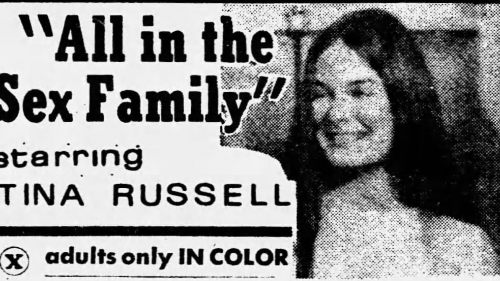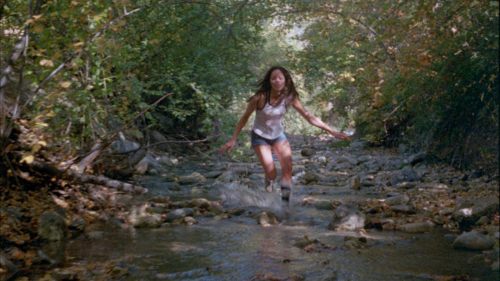Learning All The Wrong Things About Sex From Late Night Cable In The ‘80s
Pornography used to be hard for this kid to get. There was no internet. Even if we'd had a VCR, I could not rent X-rated movies. I was similarly not legally able to buy my own copies of Hustler and Oui, those third-tier skin mags greedily stashed away somewhere by my older brothers. I was condemned to ogling lingerie catalogs, the pathetic, pervy purview of the under 14 set. As such, I was positively rocked by the revelation in the early 1980s that I could see people having sex on television. WHT (Wometco Home Theater) was an NYC-based pay channel that ran over the airwaves in the five boroughs and New Jersey, and if you weren’t a subscriber with a wood-paneled descrambler box, you could nevertheless sort of see (and definitely hear) the movies they were running. After 11PM, those movies were mostly softcore porn. I remember squinting through WHT’s scrambled “Nightcap” programming block to see what looked like Paul Shaffer banging someone while wearing giant stereo headphones. And I was RIVETED, absolutely taken with the notion that you could watch people having sex on TV if you had WHT or cable. And my then-best friend Chris had cable.
Trapped in a world not yet saturated with porn, Chris and I would vault certain T&A programmers on the premium channels into the annals of legend, fastidiously hunting them down on the cable box after Chris’ parents went to bed. H.O.T.S. was a popular choice. Private Lessons was another. (Anything with Sylvia Kristel was a solid choice, really.) But two films from this period stand out in my memory above all else, filthy dual white whales that had become mythic amongst our pre-teen male demographic. Like an early '80s precursor to Google alert, our brains were trained to scan TV listings and sound the alarms should these films surface on the cable schedule. The films were The Seduction and Tattoo.
I barely recalled these films before rewatching them this past week. Of The Seduction, I only remembered Morgan Fairchild’s gravity-defying, impossibly pink nipples, and I vividly recalled the shot in which her boyfriend (Michael Sarrazin) is stabbed in the back while fucking her in a hot tub, as Fairchild's character mistakes his death spasms for an orgasm. That was a weird moment for 12-year-old me to process. And the only thing I recalled from Tattoo was the climactic sex scene, in which two inked-up bodies writhe around in disorienting close-up, the illustrations on their flesh seemingly coming to life.
It was a surprise to rediscover how remarkably similar the two films were. Both The Seduction and Tattoo feature quiet artist types (Andrew Stevens and Bruce Dern, respectively) plummeting into deadly obsession over women who are, perhaps, prone to such fetishization (in The Seduction, a TV news anchor; in Tattoo, a fashion model). “Plummet” is perhaps incorrect; both men show up at the opening credits with pretty dysfunctional ideas about love and affection, barely maintaining a mask of sanity for the outside world. Both take common courtesy from their respective objects of desire to mean emotional reciprocation. And both eventually assault their prey with their “art” (a camera in The Seduction; a tattoo gun in Tattoo.)
1982’s The Seduction rides a weird line between thriller and slasher film (“erotic thriller” seemingly hadn’t been invented yet - certainly both these films are prototypes and stepping stones), and at the time it was categorized as a horror movie. That’s not surprising, as it comes from Irwin Yablans, the producer of Halloween, and is directed by David Schmoeller, who helmed the classic sorta-slasher Tourist Trap, as well as a number of pictures for Charles Band’s Full Moon shingle. Released by then-ubiquitous Avco-Embassy, The Seduction got a lot of attention at the time for a) being the first starring vehicle for prime-time TV sexpot Morgan Fairchild; b) for getting Fairchild naked in a couple scenes; and c) for being terrible. (The Best, Worst, And Most Unusual: Horror Films, my go-to horror reference guide back then, called the film “sick and perverted...we feel sick and unclean just for having watched.”)
In The Seduction, a handsome photographer creep named Derek (Andrew Stevens) relentlessly pursues Jamie Douglas (Fairchild), a TV news anchor he believes is in love with him. When she rejects him, Derek becomes a dangerous threat to Jamie and her loved ones. It’s TV-movie stuff, a pervy riff on Cape Fear in which a terrorized protagonist, abandoned by the law, must take matters into her own hands. But there’s also a lot of slasher film shorthand in The Seduction. It’s one of the films of the period to make really great use of the piercing old-school ring of a telephone. In an era before cell phones, Derek seems eerily adept at constant contact. He can get Jamie on the phone, over and over, wherever she is - at home, at work, at a friend's, in stores - and the shrill telephone ring becomes more than a jump scare, turning into a shrieking harbinger of danger. Derek is similarly preternatural in his ability to be almost anywhere the plot needs him to be; time and distance and locked doors matter not to this obsessed maniac. The film’s centerpiece (and the reason for its schoolyard infamy) is Morgan Fairchild’s amazingly brief nude scene in which Derek, hiding in a closet and stroking his sweat-soaked chest, watches Jamie take a bubble bath. It’s weird and gross but also surprisingly chaste, with Fairchild flamboyantly soaping herself up in a scene that would barely get an R rating today.
Big surprise: there’s some troublesome stuff happening under the surface of The Seduction, starting with its main character. Jamie is a TV star, objectified by cameras within the film both before Derek sets his voyeuristic gaze upon her, and before horny pre-teen viewers waiting for that nude scene ever showed up. Her objectification in the film is all-encompassing; none of the filmmakers seem to notice or care that Jamie’s boyfriend, boss, TV audience and murderous stalker all seem to hold her in the same one-dimensional regard. She’s property, a commodity, and it’s odd to watch every action of this lead character be decided by the men around her. Several characters (and some reviews of the time) mention that Jamie should be into Derek, because he’s so good-looking. When she rebuffs him politely and firmly, he apologizes - by showing up unannounced in her dressing room with a gift. Seemingly resigned in this moment to not getting the girl, Derek begins to leave - and then Jamie smiles at him and thanks him for the gift. That’s all Derek needs, and the phone calls and stalking begin anew. There’s an uncomfortable “she’s asking for it” undercurrent to this moment. Is the film suggesting that Jamie wasn’t firm enough in her rebuke? That her polite smile and “thank you” is a form of encouragement? Maybe not, though 12-year-old me was about as capable of gleaning that as the psychotic Derek.
Through attrition and happenstance (and the aforementioned hot tub deathgasm), we’re left with Jamie and Derek facing off to the death in the finale. After proving to be a terrible aim with a shotgun, Jamie finally makes good on the film's tagline: “Now she’s fighting back with the only weapon she has...Herself!” Luring Derek back to her home with the promise of sex, Jamie shatters our villain’s psyche...by trying to rape him. Predator becomes weepy prey as Derek, freaked out (as we all might be) by Morgan Fairchild shouting "Fuck me!", is reduced to an impotent mass of tears. “You’re not a MAN!” she hisses. (What was the plan here? If Derek was DTF, how would this movie have ended?) Derek flies into a rage and attempts to kill Jamie, but is gutshot by his photography assistant, jilted earlier by the psycho for being only almost as pretty as Morgan Fairchild. It’s a weird note on which to end a film promoted as a woman’s “fighting back” story.
Unquestionably the better made film of the two, 1981’s Tattoo is also, somehow, a good deal more problematic than The Seduction. Where Andrew Stevens’ Derek is a one-dimensional threat, little more than The Shape with a hard-on, Bruce Dern’s Karl Kinski is just as dangerously insane, but here he’s our protagonist, the audience's touchstone during this tale of twisted love.
The film first presents Karl at the moment his passion is awakened - as a young GI in Japan, mesmerized by a ceremony involving dozens of tattooed men on parade. Karl, wide-eyed and intense, photographs the action as we watch in slow motion, the camera reciprocating and reflecting Karl’s fetishization of the adorned skin. We jump forward in time and find Karl running a successful tattoo shop in Hoboken, where he seems like a pleasant and quiet professional who takes pride in his work. While dealing with his recently deceased father’s estate, Karl is tapped by a fashion photographer (Leonard Frey) to apply some faux ink onto a bevy of fashion models for a tattoo-themed shoot. As fate would have it, one of the models is Maddy (Maud Adams), over whose face and body Karl has been obsessing at magazine stands. After Maddy washes off Karl's artwork and initiates a casual date that Travis Bickle might call a success, Karl is soon stalking the disinterested beauty, and before long he’s chloroforming her and imprisoning her in his father's abandoned beach house, claiming her body as his own personal canvas.
Tattoo comes from more respectable cinematic ilk than the horror-movie pedigree of The Seduction. But I’m not sure if that lessens or intensifies the sleazy vibe. There’s some dark, unsettling stuff in here, and seeing it played out by a top-shelf actor like Bruce Dern makes it all feel a bit more... wrong. Dern’s Karl is a glorious weirdo. His days as a pay phone sanitizer have made him germ-phobic and afraid to put his mouth near a phone, and he possesses a puritanical streak seemingly at odds with his profession (the first tattoo we see him creating is a naked woman’s spread legs, etched onto a man’s armpit). Maddy casually suggests sex with Karl on their first date, but Karl will have nothing to do with it unless she makes an exclusive commitment. Later, when she’s his captive, there’s a horrifying peephole jerk-off scene that predates (and runs circles around) the ones in Bob Clark’s Porky’s and Ken Russell’s Crimes Of Passion. Tattoo’s plot, locales, themes of sexual obsession and repression - hell, even its film stock - combine to make the whole thing feel like the sleaziest film Paul Schrader never made. The film became somewhat infamous when Dern started telling interviewers the sex scene between Maud Adams and himself was unsimulated. Adams denied it. Director Bob Brooks never made another feature.
Thinking back, the illicit appeal of these movies - the reasons I hunted them down - was not about how sexy they were. Indeed, the nude scenes in The Seduction are so fleeting as to be downright coy, and the one lovemaking scene is also a murder scene. To call the lone sex scene in Tattoo "erotic" would be to fundamentally misunderstand the film you'd watched up to that point. No, the appeal of these movies was inextricably tied to the idea that I recognized the actresses getting undressed, the notion that I wasn’t supposed to be seeing these women naked. After all, these weren’t just some nobodies disrobing for the cameras; everybody knew who Morgan Fairchild was! She was on Mork & Mindy! And Maud Adams was a Bond Girl from 1974’s The Man With The Golden Gun (two years after Tattoo, she’d return to that franchise, playing the title role in Octopussy). Within the already-forbidden realm of “sex on your television” - again, a pretty incongruous experience in 1982 - seeing these beauties from the mainstream baring all seemed like an even bigger taboo, and it no doubt made the objectification happening on this side of the screen even more intense.
That I showed up objectifying the women in these films, films that were explicitly about objectifying and possessing the characters they were playing, was an accident. But I have to wonder if the thematic similarity of these films, coupled with their illicit, "holy grail" nature at the time, helped give the 12-year-old kid watching it a really unhealthy model for sexuality, relationships and women. When you were 12, or rather when I was 12, every woman on earth was unattainable. I was effectively invisible, powerless and had no hope of ever connecting with them. That level of insignificant nothingness is a bad combo for a pre-adolescent with mood swings and a 24-hour boner. With not too many real-world models from which to take relationship cues, and with John Hughes' happy endings a couple years away yet, I had to work with what I had, and in these pair of films I got some bad news. Even when you’re an adult, these movies said, the woman you want more than anything will have nothing to do with you. You’re going to be stuck admiring and obsessing from afar. At 12, I already believed this to be the case; these movies reinforced it. I just wanted to see some breasts, and instead I was being imprinted with some incredibly wrong-headed ideas about what love was, and how the larger world of sexuality and relationships even worked. As I moved into adolescence, I saw two kinds of love: my parents’, which was mostly yelling and fighting, and the love I saw in movies like The Seduction and Tattoo, where it was all-consuming, dangerously obsessive and unrequited. These two facets were mirrored in my relationships for years: I was all in when it came to love and affection, but the day to day of a relationship ended up looking like my parents’ 22 year marital war. Then when a relationship went south I’d be a monster about it, treating breakups like the end of the world. Was this how I would see the world forever, with women as unattainable objects to be coveted and possessed, and then harassed and terrorized when they didn’t hold up their end of the fantasy? Is that how it worked in the real world? What the fuck had I done to myself?
As I matured, I’d like to think I stopped thinking of women in those binary terms, as either desirable possessions or as sources of wounded, emo pain. Through trial and error and a handful of bad relationships I eventually stopped equating love with possession, and I stopped casting myself in situations that reinforced the idea rattling in my head that I wasn’t worthy of someone’s love. I evolved; I grew up. (And there was much rejoicing.) But it’s telling - and troubling - that when, over the years, feelings of jealousy, of coveting and obsession flared up, it wasn’t the classy, romantic Hitchcock variety, or even the lurid-yet-polished De Palma version of obsession that were recalled. In the real world, the dark, sour obsession seen in this pair of films is what still comes to mind. Even today, the ugly, immature ruthlessness in these two films feels more to me like the real-life version of love gone bad.



